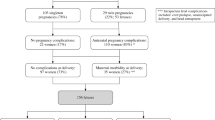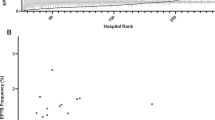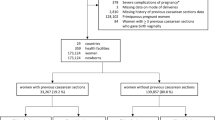Abstract
OBJECTIVES:
We describe national trends in cesarean delivery rates among macrosomic infants during 1989 to 2000 and evaluate the maternal characteristics and risk factors for macrosomic infants delivered by cesarean section as compared to macrosomic infants delivered vaginally.
STUDY DESIGN:
We analyzed US 1989 to 2000 Natality files, selecting term (37 to 44 week) single live births to U.S. resident mothers. We compare macrosomic infants (4000 to 4499, 4500 to 4999 and 5000+ g infants) to a normosomic (3000 to 3999 g) control group.
RESULTS:
The proportion of cesarean deliveries among 5000+ g infants increased significantly over the time period. The adjusted odds ratio of cesarean delivery increased for all macrosomic categories over the 12-year period, as compared to normal birth weight infants.
CONCLUSIONS:
Rates of cesarean delivery among macrosomic infants continue to increase despite a lack of evidence of the benefits of cesarean delivery within this population. Further exploration of the rationale for this trend is warranted and should include the development of an optimal delivery strategy for such patients.
This is a preview of subscription content, access via your institution
Access options
Subscribe to this journal
Receive 12 print issues and online access
$259.00 per year
only $21.58 per issue
Buy this article
- Purchase on Springer Link
- Instant access to full article PDF
Prices may be subject to local taxes which are calculated during checkout


Similar content being viewed by others
References
Boulet SL, Alexander GR, Salihu HM, Pass M . Macrosomic births in the united states: determinants, outcomes, and proposed grades of risk. Am J Obstet Gynecol 2003;188 (5):1372–1378.
American College of Obstetricians and Gynecologists. ACOG Practice Bulletin No. 22. Washington, DC: ACOG; 2000.
Weiner Z, Ben-Shlomo I, Beck-Fruchter R, Goldberg Y, Shalev E . Clinical and ultrasonographic weight estimation in large for gestational age fetus. Eur J Obstet Gynecol Reprod Biol 2002;105 (1):20–24.
Rouse DJ, Owen J . Sonography, suspected macrosomia, and prophylactic cesarean: a limited partnership. Clin Obstet Gynecol 2000;43 (2):326–334.
Kolderup LB, Laros Jr RK, Musci TJ . Incidence of persistent birth injury in macrosomic infants: association with mode of delivery. Am J Obstet Gynecol 1997;177 (1):37–41.
Nesbitt TS, Gilbert WM, Herrchen B . Shoulder dystocia and associated risk factors with macrosomic infants born in California. Am J Obstet Gynecol 1998;179 (2):476–480.
Gregory KD, Henry OA, Ramicone E, Chan LS, Platt LD . Maternal and infant complications in high and normal weight infants by method of delivery. Obstet Gynecol 1998;92 (4 Part 1):507–513.
Menacker F, Curtin SC . Trends in cesarean birth and vaginal birth after previous cesarean, 1991–99. Natl Vital Stat Rep 2001;49 (13):1–16.
Sachs BP, Kobelin C, Castro MA, Frigoletto F . The risks of lowering the cesarean-delivery rate. N Engl J Med 1999;340 (1):54–57.
Roberts CL, Algert CS, Carnegie M, Peat B . Operative delivery during labour: trends and predictive factors. Paediatr Perinat Epidemiol 2002;16 (2):115–123.
Ananth CV, Demissie K, Kramer MS, Vintzileos AM . Small-for-gestational-age births among black and white women: temporal trends in the United States. Am J Public Health 2003;93 (4):577–579.
Kramer MS, Morin I, Yang H, et al. Why are babies getting bigger? Temporal trends in fetal growth and its determinants. J Pediatr 2002;141 (4):538–542.
Wen SW, Kramer MS, Platt R, et al. Secular trends of fetal growth in Canada, 1981 to 1997. Paediatr Perinat Epidemiol 2003;17 (4):347–354.
Brost BC, Goldenberg RL, Mercer BM, et al. The Preterm Prediction Study: association of cesarean delivery with increases in maternal weight and body mass index. Am J Obstet Gynecol 1997;177 (2):333–337; discussion 337–41.
Rhodes JC, Schoendorf KC, Parker JD . Contribution of excess weight gain during pregnancy and macrosomia to the cesarean delivery rate, 1990–2000. Pediatrics 2003;111 (5 Part 2):1181–1185.
Witter FR, Caulfield LE, Stoltzfus RJ . Influence of maternal anthropometric status and birth weight on the risk of cesarean delivery. Obstet Gynecol 1995;85 (6):947–951.
Arias E, MacDorman MF, Strobino DM, Guyer B . Annual summary of vital statistics--2002. Pediatrics 2003;112 (6 Part 1):1215–1230.
NCHS. 1989–2002 natality data sets. NCHS CD-ROM Series 20, No. 4. Hyattsville, MD: US Dept Health and Human Services, Centers for Disease Control and Prevention; 1989–2000.
Alexander GR, Kotelchuck M . Quantifying the adequacy of prenatal care: a comparison of indices. Public Health Rep 1996;111 (5):408–418; discussion 419.
Haas JS, Udvarhelyi S, Epstein AM . The effect of health coverage for uninsured pregnant women on maternal health and the use of cesarean section. JAMA 1993;270 (1):61–64.
Gould JB, Davey B, Stafford RS . Socioeconomic differences in rates of cesarean section. N Engl J Med 1989;321 (4):233–239.
Braveman P, Egerter S, Edmonston F, Verdon M . Racial/ethnic differences in the likelihood of cesarean delivery, California. Am J Public Health 1995;85 (5):625–630.
Peipert JF, Hogan JW, Gifford D, Chase E, Randall R . Strength of indication for cesarean delivery: comparison of private physician versus resident service labor management. Am J Obstet Gynecol 1999;181 (2):435–439.
Poma PA . Effects of obstetrician characteristics on cesarean delivery rates. A community hospital experience. Am J Obstet Gynecol 1999;180 (6 Part 1):1364–1372.
Gregory KD, Korst LM, Platt LD . Variation in elective primary cesarean delivery by patient and hospital factors. Am J Obstet Gynecol 2001;184 (7):1521–1532; discussion 1532–4.
Blackwell SC, Hassan SS, Wolfe HW, Michaelson J, Berry SM, Sorokin Y . Why are cesarean delivery rates so high in diabetic pregnancies? J Perinat Med 2000;28 (4):316–320.
Reichman NE, Hade EM . Validation of birth certificate data. A study of women in New Jersey's HealthStart program. Ann Epidemiol 2001;11 (3):186–193.
Buescher PA, Taylor KP, Davis MH, Bowling JM . The quality of the new birth certificate data: a validation study in North Carolina. Am J Public Health 1993;83 (8):1163–1165.
Acknowledgements
This work was supported in part by DHHS, HRSA, MCHB Grant 5T76MC00008.
Author information
Authors and Affiliations
Rights and permissions
About this article
Cite this article
Boulet, S., Alexander, G. & Salihu, H. Secular Trends in Cesarean Delivery Rates among Macrosomic Deliveries in the United States, 1989 to 2002. J Perinatol 25, 569–576 (2005). https://doi.org/10.1038/sj.jp.7211330
Published:
Issue Date:
DOI: https://doi.org/10.1038/sj.jp.7211330
This article is cited by
-
Trends in the incidence of fetal macrosomia and its phenotypes in the United States, 1971–2017
Archives of Gynecology and Obstetrics (2020)
-
Length and weight of newborns in Croatia from 1985 to 2009
Wiener klinische Wochenschrift (2015)
-
Labor and Delivery Experiences of Mothers with Suspected Large Babies
Maternal and Child Health Journal (2015)
-
Possible relation between maternal consumption of added sugar and sugar-sweetened beverages and birth weight – time trends in a population
BMC Public Health (2012)
-
Trends in Pre-pregnancy Obesity in Nine States, 1993–2003*
Obesity (2007)



